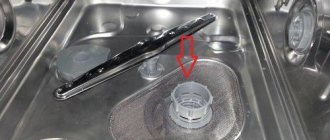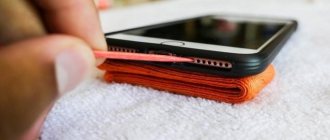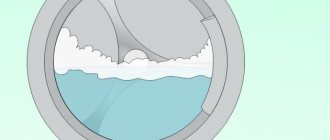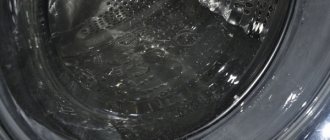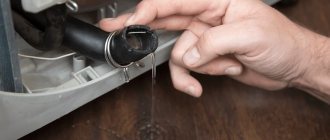Causes of appearance Difficulty of repair
Have you opened the refrigerator and noticed water under the drawers, or water leaking from the chambers? Or maybe you found it on the walls? What happened? Take a closer look at your refrigerator - ice may form in the water drainage hole. This is often accompanied by unpleasant odors.
There is ice in the main compartment, but only in one place - usually it collects on the back wall. This is not typical for every refrigerator, but only for models equipped with drip defrosting. If water accumulates under the drawers, be careful - it shouldn't be there.
Good news! Water in the refrigerator is not necessarily evidence of a breakdown. Sometimes it appears in cameras for independent reasons or due to user negligence. Many situations can be resolved on your own.
Below you will find an overview of the main reasons for this phenomenon and a brief guide to action.
Common reasons
In this section, we will describe common reasons why water may accumulate under the fruit and vegetable drawers in your refrigerator. They apply to both units with a drip system and No Frost, Total Frost.
Stopper in the drain
Condensation accumulates in every refrigerator. It flows into a special tray through a drainage hole. The moisture container is located directly above the compressor on the rear wall. The water in the tray heats up when the compressor operates and evaporates.
A common cause of water appearing in the refrigerator compartment is a clogged drain. The drain hole can be located immediately behind the boxes for vegetables and fruits, or on the back wall , in a special channel. It’s easy to check the permeability - pour 250-300 ml of water into it. If she doesn't go away, there's a problem. A traffic jam can form for two reasons:
- Dirt has accumulated in the drain tube;
- Microorganisms (fungus, mold) have settled in the drainage.
Cleaning the drain hole is simple. If the blockage is small, a regular syringe (bulb, enema, etc.) will help. You need:
- Make a weak solution of detergent;
- Pour it into a syringe;
- Insert it into the drainage so that the hole is completely blocked;
- Squeeze the solution down the drain.
If you can't rinse with a syringe, it's time for the big guns. You will need a piece of wire 60-80 cm long and some fabric or rags: you will need to make an improvised brush:
- Wrap the fabric around the end of the wire until it holds tightly;
- The winding diameter should be half the drain diameter;
- Pour 20-30 ml of detergent into the drain hole;
- Clean the drain hole;
- After removing the plug, rinse the drain and tray with plain water.
Important
It is not recommended to use water without detergent. Household chemicals will help get rid of microorganisms that cause unpleasant odors in the refrigerator. Even if it’s not there, a little prevention won’t hurt.
Icing of drainage
In some cases, ice may accumulate in the drain tube. This often happens when the drain is located at the bottom of the refrigerator, above the freezer. If you were unable to break through the drain using the methods described above, there is most likely an ice blockage.
There are three ways to solve the problem. For the first one you will need:
- Disconnect the refrigerator from the power supply;
- Pour 1-2 teaspoons of salt into the drainage;
- Wait until the salt dissolves the ice (usually no more than 1 hour);
- Flush the drainage with plain warm water.
In the second case, you will need a regular or small hair dryer. Simply blow warm air into the drain hole and wait until the ice melts. The third method is the simplest. Just pour hot water up to 60 degrees into the drain and wait until the ice melts.
Warming up the drainage hole in the lower part of the refrigerator with a hairdryer.
Deformation and improper installation
In some refrigerators, the drain is located in the bottom of the chamber on the back wall. Water flows into it due to the tilt of the bottom panel. If the angle of inclination is small and less than 5 degrees , even a slight deformation will lead to the accumulation of water under the drawers.
It’s easy to check if the bottom wall is bent:
- Take out the vegetable crates;
- Rinse the bottom of the chamber and wipe dry;
- Pour half a glass of water on it.
If the water does not flow into the drain, or does not go completely, there is a problem. Perhaps the bottom of the chamber is deformed, concave. But there is another option - the refrigerator is installed with a slight tilt forward. There are two solutions to the issue:
- Tilt the refrigerator back by twisting the legs or placing something under them;
- Call a specialist to level the bottom of the chamber or replace it.
Hot and cold
If the drain hole is located on the back wall of the refrigerator, pay attention to the side ones. When condensation accumulates on them, it forms droplets. They flow down under the boxes. This most often happens when you put hot or warm food and dishes in the refrigerator.
When something warm is placed in the chamber, a large temperature difference results. Condensation accumulates on chilled dishes, shelves and walls and flows down. If the drainage is located on the back wall, it collects water only from it. The rest will flow under the vegetable drawers.
The only solution to the problem is to get rid of the bad habit. Do not put heated food in the refrigerator. In addition, this can lead to other problems. Read more about this in the article “Why you can’t put hot food in the refrigerator.”
Door problems
The constant flow of air from outside the refrigerator is the cause of condensation. When warm air hits cooled food and walls, moisture condenses from it. It flows down and can accumulate under vegetable containers. There are two reasons for air entering from outside:
- Worn seal;
- Doors that do not fit tightly.
You can determine the condition of the sealing rubber visually. If it is cracked, lost elasticity or deformed, it must be replaced. You can do this yourself, you just need to buy a new seal and high-quality glue.
Over time, door hinges may become warped. Because of this, the sash will not fit tightly. To determine this problem, measure the distance between the door and the cabinet along the entire perimeter. The spread should not exceed 2 mm .
If the door is skewed, call a professional. It is unlikely that you will be able to adjust the hinges or change them yourself. This requires experience and a special tool. In modern models they are recessed into the body and are difficult to replace. find a refrigerator repair specialist on the Pro portal.
Power outages
Water under vegetable containers may appear due to a temporary refrigerator shutdown . The reason for this is power outages. When the unit is turned off, the products heat up and moisture from their surface evaporates. After switching on, it condenses on the walls, shelves, and bottom of the chamber.
This most often happens if food is stored in open or loosely closed containers. This is especially true for chopped and liquid foods:
- Vegetables and fruits;
- Soups;
- Broths;
- Raw meat.
With periodic power outages, it is difficult to solve the problem. You can only reduce the consequences . For this we recommend:
- Store food in tightly closed containers;
- Food should be whole, not chopped;
- Store raw meat and semi-finished products in the freezer;
- Do not defrost food in the main compartment.
Proper storage of raw meat in the refrigerator. In this case, the film protects against moisture evaporation.
Electronics are to blame
If none of the options solve your problem, the problem may be electronic. If the temperature sensor fails, the refrigerator may not operate smoothly. In this case, the moisture will alternately evaporate and condense. Condensation will flow down the walls and accumulate under the drawers.
If the drainage hole is located under the fruit and vegetable boxes, then the water should drain freely. If this does not happen, there may be other reasons. For example, your refrigerator has a clogged drain and problems with the electronics at the same time.
Diagnosing problems with the sensor is difficult. Without the help of a technician, you can only check the set mode and the actual temperature in the chamber. To do this, you can use a regular outdoor thermometer.
Important
The refrigerator takes time to cool the compartment. It depends on the volume of food and at what temperature it was placed in it. The power of the unit and the type also play a role. The time to reach the desired temperature can range from 10 minutes to 1 hour.
You can replace the temperature sensor yourself if you have basic skills in repairing electrical appliances. If there is a problem with the control board, everything is much more complicated. It's best to call a professional. You can find a good refrigeration specialist in your city on the specialist search portal.
How to eliminate condensation in the refrigerator yourself
When it comes to violations of the rules for using refrigeration equipment, the formation of condensation is temporary.
It is easy to get rid of the problem by eliminating the specific cause. That is why manufacturers recommend carefully reading the operating instructions, which always come with a specific refrigerator model. If the problem is related to the formation of a blockage, then you need to do the following:
- clean the drainage hole using a special brush or any available tool (toothpick, match, etc.);
- clean the tube using a thin wire 20–30 cm long.
If the reason lies in a violation of the seal of the chamber, then you need to check whether the door itself hangs correctly. It is possible that a misalignment has occurred during operation. Using the appropriate tools, the door is brought into the desired position. If the problem is with the seal, then first check its position in the channel (groove). If it comes out of the recess using a hairdryer, the element can easily be returned to its place. If defective, the rubber seal must be replaced.
Subscribe to our Social networks
What kind of refrigerator do you have?
There are two main types of refrigerators:
- With drip system;
- No Frost (Total no frost, Full no frost).
They have specific reasons for the appearance of water under the boxes for vegetables and fruits. Determining which system your refrigerator has is easy. In drip-type refrigerators, the back panel of the chamber is solid. In Know Frost refrigerators (and similar ones) there are holes in it for airflow into the chamber.
In the No Frost system, the evaporator is located behind the rear wall. There are also 1,2 or more fans installed there. They force air through the evaporator and blow it into the chamber. This ensures fast cooling of food.
Refrigerators with a drip system are also called weeping refrigerators. Their evaporator is located behind a solid rear wall. Condensation accumulates on it and flows down. The drainage hole is located either in a special groove on the wall or in the bottom of the chamber.
Determining the type of refrigeration unit
To understand why water has accumulated under the fruit boxes, you must first understand how the refrigerator is designed and works. Modern units with two or more chambers are divided into two types based on their operating principle:
- Drip defrosting system . Refrigerators of this type have a special evaporator. At the moment of cooling, it and the back wall inside the chamber are covered with a thin layer of frost. As soon as the temperature reaches the desired level (+4 +8 °C), the cycle stops. As a result, the resulting frost melts, forming droplets of water. All liquid flows into a separate tank, where it completely evaporates.
Drip defrosting system
- No Frost system. In units of this type, the refrigerator compartment is not equipped with an evaporator. The entire cooling cycle occurs with the participation of the freezer evaporator. Cold air is forced into the chambers using a fan through a specially designed channel system. When the desired temperature is reached, the system closes the air dampers and the supply of cooled air stops. As soon as the air becomes a little warmer, the valves open again.
We examined this system in more detail in our article: No Frost - what kind of system is this in the refrigerator, pros and cons, myths and reality
No Frost System
Water in the refrigerator No Frost
If water accumulates in the No Frost and general recommendations do not help, read on. Refrigerators with this system have two specific causes of moisture accumulation. This is insufficient airflow and freezing of the evaporator.
Airflow problems
It happens that one fan or several fans fail. Then air circulation deteriorates, and zones with different temperatures appear in the chamber. This leads to uneven evaporation and condensation of moisture .
For example, at the top of the refrigerator the temperature is +4. And the fan in the middle part blows out air with a temperature of -2. Because of this difference, the following happens:
- Moisture evaporates at the top of the refrigerator compartment;
- Due to the airflow, it falls into the middle part;
- When faced with a flow of cold air, water condenses;
- Condensation flows down and accumulates under the vegetable containers.
Determining whether there are problems with the fans is difficult. To do this, you need to unload the refrigerator, remove the back panels and inspect them visually. If the fan does not work, there are three options:
- The fan motor has failed;
- The impeller or pulley is frozen or clogged;
- There is no power supplied to the motor.
In cases 1 and 2, you can solve the problem yourself - replace the fan or clean it. In case 3, everything is more complicated. There may be a problem with the wiring or the electronic system control board. Only a specialist who can be found on the specialist search site can find the cause.
A standard fan for blowing a No Frost refrigerator in disassembled form.
Ice that doesn't melt
If there is a malfunction, ice and snow may accumulate on the refrigerator evaporator. When air is blown through it, it cools excessively. Getting into the chamber, it promotes moisture condensation. There are several reasons for ice accumulation:
- One of the airflow holes is clogged;
- There is a freon leak;
- The temperature sensor is faulty;
- Problems with the control board.
In the first case, everything is simple - you can visually inspect the holes and clean them if necessary. In the rest, you need to call a specialist. We recommend that you first familiarize yourself with the common causes of water appearing under fruit and vegetable drawers. If you cannot correct the situation yourself, contact a specialist.
Ice frozen on the refrigerator evaporator.
Tips for care and use
To make your refrigerator last longer, you need to follow these recommendations:
- The chamber door can only be opened by the handle, otherwise the rubber seal may be deformed.
- To prevent the seal from cracking, it must be regularly treated with a special silicone grease.
- Do not place hot or warm products in the refrigerator.
- Care must be taken to ensure that food and packaging do not touch the evaporator.
- You should not set the temperature as low as possible, especially in summer.
- The device must be defrosted periodically. For No Frost refrigerators, it is enough to perform this procedure once a year.
- It is forbidden to try to break off the ice with sharp objects.
Water does not drain in the drip refrigerator
Refrigerators with a drip system have their own characteristics. Accordingly, there are specific reasons for the accumulation of water under containers for vegetables and fruits. Below we describe the two most common ones.
Food storage
Refrigerators with a drip system do not have forced air. Therefore, the air is poorly mixed, the temperature in the chamber is uneven . Especially if the products are located close to the walls.
At the same time, air circulation becomes difficult; it is colder near the walls than in the chamber. Due to temperature changes, condensation accumulates on them. It flows down and ends up under the vegetable drawers. If the drainage is located on the back wall, there will be nowhere for moisture to go.
Freezing of walls
If water is pooling under drawers, inspect the back wall. There should be no frost, ice or snow on it. When the compressor turns off or you put something warm in the refrigerator, the ice begins to melt . Water flows down and accumulates under the drawers.
To get rid of ice or frost, you need to find the cause of its formation. We wrote more about this in the article: Why the back wall of the refrigerator freezes: we look for the cause and eliminate it.
In this article, we looked at why water accumulates in the refrigerator under the drawers for vegetables and fruits. We hope it helped you troubleshoot the problem. You can leave your questions and opinions in the comments. Don't forget to share the post with your friends !
Do you want to get help from a master, a specialist in this field?
Go to the professional search portal. This is a completely free service where you will find a professional who will solve your problem. You do not pay for posting an ad, views, or choosing a contractor. If you are a master of your craft, then register on Pro and receive a flow of clients. Your profit is just one click away!
Water collects under vegetable boxes - why is this bad?
The presence of moisture inside the device is only allowed on the rear panel. This applies to refrigerators with a “crying” (drip) defrosting system. If condensation accumulates in the wrong place, this does not necessarily indicate a breakdown. But it is better to eliminate the defect, otherwise it can provoke unpleasant consequences:
- Corrosion of metal. The metal part between the freezer and the refrigerator compartment is quickly damaged by corrosion in conditions of high humidity. The resulting rust corrodes the body and reduces aesthetics.
- Condensation can get under the frame where the heating housing passes. This is more serious. A rusty pipe is the cause of depressurization and costly repairs.
It is recommended not to start the problem, but to eliminate it at the first symptoms. To do this, you need to know the reasons that cause moisture droplets to accumulate at the bottom of the refrigerator under the container.
Bacteria killers
To cope with pathogenic bacteria, you should use effective means.
- Soap and soda solution. To flush the drainage, you should make a solution based on soda and soap. To do this, it is recommended to mix 50 grams of laundry soap and 1 tablespoon of soda. This amount is stirred in 1 liter of water. The prepared liquid should be collected in a syringe and pressed into the hose.
- Chlorine-containing preparations. Preparations containing chlorine are excellent for destroying bacterial microorganisms. The downside of such products is the strong aroma.
- Dezavid. Dezavid is considered a good option. It is pumped into the tube using a volumetric syringe. In this case, first the opposite end should be sealed. To clean the device from pathogenic bacteria, it is permissible to use hydrogen peroxide. To do this, take a solution with a concentration of 3%. It is poured into the hole with a syringe or syringe.
Signs of a freon leak
Several decades ago, different types of freon were used to manufacture cooling equipment. Laboratory studies of samples conducted by scientists have proven that some types of gas can harm the planet's ozone layer and are dangerous for domestic use.
Harmful types of freon are prohibited for use today. New refrigerators use environmentally friendly refrigerants that are odorless and colorless. This means that it will not be possible to find out about a freon leak by external signs.
- You can determine if there is a problem by observing the operation of the device. If the refrigerator begins to work worse, the desired temperature is not maintained inside, and food spoils quickly and smells unpleasant, this may indicate a lack or leak of refrigerant.
- The problem can be determined by the amount of condensation on the walls of the cooling chamber. Without the required volume of freon, the compressor begins to operate at low pressure, the temperature inside becomes higher and condensation forms on surfaces. Glass surfaces fog up, food defrosts and spoils.
New refrigerator models are created using safe freon
Gas may not harm people, but this does not mean that the leak is not worth paying attention to. If a breakdown is detected, contact a specialist
Untimely intervention threatens the failure of the compressor or engine, the replacement of which will cost much more. The refrigerator can be repaired by a trained technician at a service center or at home.
Repair at home or in the workshop?
For a refrigerator owner, restoration in a workshop is a real challenge.
You need to hire movers and transport, deliver equipment, allocate time and money for these processes. Recovery may take a long time, and during this period the apartment will be left without the most important element of household appliances. Spoiled food and lack of food at home are unlikely to cheer you up. So it’s worth ordering home service. The main repair procedures in this case will be as follows:
- cleaning the drainage and inspecting the system for possible obstacles to draining water;
- replacing the rubber seal on the door or cleaning the contact surface with the seal;
- eliminating leaks in chambers that can lead to condensation;
- working with freon - refilling or replacing refrigerant, oil, pressure control;
- cleaning the circulation system or replacing its parts for efficient operation;
- replacing the compressor if diagnostics reveal its ineffective operation.
All these procedures can be performed at your home within 2-4 hours. The technician will not only find out why excess moisture appears, but also eliminate the real causes of breakdowns. This way, your equipment will last for several more years, and you won’t have to spend money on new equipment. If the condensation does not go away, you should call specialists to your home and order diagnostics, as well as repair of the refrigerator. This way you can avoid big expenses. The sooner the technician arrives and performs the service, the cheaper the service will cost. Problems in the early stages are much easier to fix than when the main working parts of the device are destroyed.
How to avoid such problems
To prevent water from accumulating in the refrigerator and leaking onto the floor, it must be used correctly. There are several recommendations for use:
- do not leave the door open, make sure it is sealed;
- food should be in containers so that crumbs do not fall into the drainage hole;
- do not place open containers with liquid inside, as it will evaporate;
- put only cold foods inside;
- When defrosting, do not use sharp objects to break off ice, as this may damage the freon tubes;
- do not touch the door seal when opening, periodically treat it with silicone grease;
- monitor the cleanliness of the internal chambers.
If water appears in the refrigerator or on the floor next to it, you need to determine the cause as soon as possible. It is recommended to defrost the equipment and find the problem. In the event that it is impossible to fix the problem yourself, be sure to call a specialist. If this is not done in time, it will lead to more serious damage to the device.
Was there a breakdown?
If you suddenly see water under the refrigerator, there is no need to panic. Calm down, a puddle is not always evidence of a breakdown. First of all, conduct a visual inspection of the unit and check the following:
- is it unplugged from the outlet?
- whether the leak was caused by nearby equipment, for example, a washing machine;
- Are liquid products stored in the refrigerator compartment securely closed with a lid (water, juices, milk, soup);
- whether the power supply in the house is broken (lack of electricity can lead to defrosting of the device);
- Are heating radiators, sinks and pipes leaking?
If, as a result of the inspection, it becomes clear that the problem is still in the refrigerator, you must immediately begin to correct the breakdown.
Attention! A refrigerator can start leaking for a variety of reasons. Almost all of them can be eliminated with your own hands, without turning to a professional.
Troubleshooting Methods
You can cope with the situation on your own, with a minimum of effort and a maximum of desire.
- Removing blockages in the drainage system:
- Disconnect the device from the power supply and defrost it.
- We clean the visible part of the drain with a cotton swab from dirt.
- We arm ourselves with a syringe or a rubber bulb and, under pressure, break through the resulting plug.
- If this does not help, then you need to clean the nozzle using a wire.
- We reanimate or replace the seal:
- We degrease the loose sections of the tape and fix them in the groove with silicone glue. Elasticity can be restored by removing the rubber and scalding it with boiling water. Installation should be carried out after the material has completely cooled.
- In the case of visible defects and a long service life, the seal must be completely replaced.
- You need to adjust the legs so that the front ones are slightly higher than the back ones - a slight tilt will ensure a better fit of the door.

